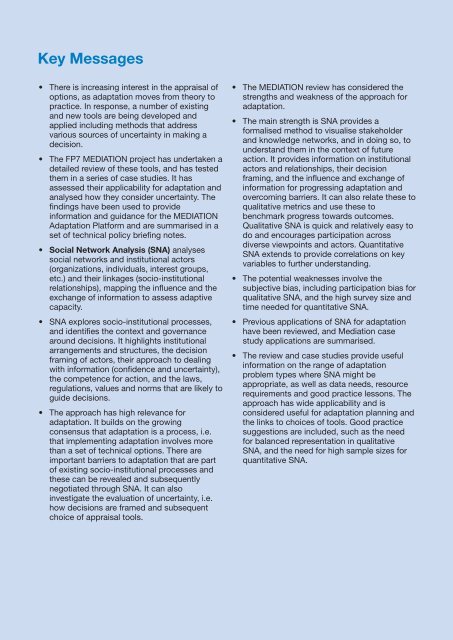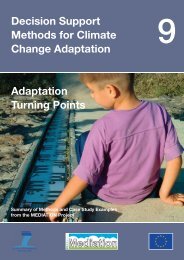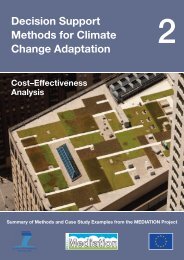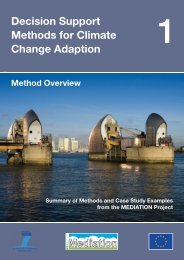Key Messages• There is <strong>in</strong>creas<strong>in</strong>g <strong>in</strong>terest <strong>in</strong> the appraisal ofoptions, as adaptation moves from theory topractice. In response, a number of exist<strong>in</strong>gand new tools are be<strong>in</strong>g developed andapplied <strong>in</strong>clud<strong>in</strong>g methods that addressvarious sources of uncerta<strong>in</strong>ty <strong>in</strong> mak<strong>in</strong>g adecision.• The FP7 MEDIATION project has undertaken adetailed review of these tools, and has testedthem <strong>in</strong> a series of case studies. It hasassessed their applicability for adaptation andanalysed how they consider uncerta<strong>in</strong>ty. Thef<strong>in</strong>d<strong>in</strong>gs have been used to provide<strong>in</strong>formation and guidance for the MEDIATIONAdaptation Platform and are summarised <strong>in</strong> aset of technical policy brief<strong>in</strong>g notes.• Social Network Analysis (SNA) analysessocial networks and <strong>in</strong>stitutional actors(organizations, <strong>in</strong>dividuals, <strong>in</strong>terest groups,etc.) and their l<strong>in</strong>kages (socio-<strong>in</strong>stitutionalrelationships), mapp<strong>in</strong>g the <strong>in</strong>fluence and theexchange of <strong>in</strong>formation to assess adaptivecapacity.• SNA explores socio-<strong>in</strong>stitutional processes,and identifies the context and governancearound decisions. It highlights <strong>in</strong>stitutionalarrangements and structures, the decisionfram<strong>in</strong>g of actors, their approach to deal<strong>in</strong>gwith <strong>in</strong>formation (confidence and uncerta<strong>in</strong>ty),the competence for action, and the laws,regulations, values and norms that are likely toguide decisions.• The approach has high relevance foradaptation. It builds on the grow<strong>in</strong>gconsensus that adaptation is a process, i.e.that implement<strong>in</strong>g adaptation <strong>in</strong>volves morethan a set of technical options. There areimportant barriers to adaptation that are partof exist<strong>in</strong>g socio-<strong>in</strong>stitutional processes andthese can be revealed and subsequentlynegotiated through SNA. It can also<strong>in</strong>vestigate the evaluation of uncerta<strong>in</strong>ty, i.e.how decisions are framed and subsequentchoice of appraisal tools.• The MEDIATION review has considered thestrengths and weakness of the approach foradaptation.• The ma<strong>in</strong> strength is SNA provides aformalised method to visualise stakeholderand knowledge networks, and <strong>in</strong> do<strong>in</strong>g so, tounderstand them <strong>in</strong> the context of futureaction. It provides <strong>in</strong>formation on <strong>in</strong>stitutionalactors and relationships, their decisionfram<strong>in</strong>g, and the <strong>in</strong>fluence and exchange of<strong>in</strong>formation for progress<strong>in</strong>g adaptation andovercom<strong>in</strong>g barriers. It can also relate these toqualitative metrics and use these tobenchmark progress towards outcomes.Qualitative SNA is quick and relatively easy todo and encourages participation acrossdiverse viewpo<strong>in</strong>ts and actors. QuantitativeSNA extends to provide correlations on keyvariables to further understand<strong>in</strong>g.• The potential weaknesses <strong>in</strong>volve thesubjective bias, <strong>in</strong>clud<strong>in</strong>g participation bias forqualitative SNA, and the high survey size andtime needed for quantitative SNA.• Previous applications of SNA for adaptationhave been reviewed, and <strong>Mediation</strong> casestudy applications are summarised.• The review and case studies provide useful<strong>in</strong>formation on the range of adaptationproblem types where SNA might beappropriate, as well as data needs, resourcerequirements and good practice lessons. Theapproach has wide applicability and isconsidered useful for adaptation plann<strong>in</strong>g andthe l<strong>in</strong>ks to choices of tools. Good practicesuggestions are <strong>in</strong>cluded, such as the needfor balanced representation <strong>in</strong> qualitativeSNA, and the need for high sample sizes forquantitative SNA.
Social Network AnalysisIntroductionThere is <strong>in</strong>creas<strong>in</strong>g policy <strong>in</strong>terest <strong>in</strong> the appraisalof options, as adaptation moves from theory topractice. At the same time, it is recognised thatthe appraisal of climate change adaptation<strong>in</strong>volves a number of major ch<strong>all</strong>enges,particularly the consideration of uncerta<strong>in</strong>ty. Inresponse, a number of exist<strong>in</strong>g and new decisionsupport tools are be<strong>in</strong>g considered foradaptation.The European Commission FP7 fundedMEDIATION project (Methodology for EffectiveDecision-mak<strong>in</strong>g on Impacts and AdaptaTION) islook<strong>in</strong>g at adaptation decision support tools, <strong>in</strong>l<strong>in</strong>e with its objectives to advance the analysis ofimpacts, vulnerability and adaptation, and topromote knowledge shar<strong>in</strong>g through aAdaptation Platform (http://www.mediationproject.eu/platform/).To complement the<strong>in</strong>formation on the Platform, a series of <strong>Policy</strong><strong>Brief<strong>in</strong>g</strong> <strong>Notes</strong> have been produced on DecisionSupport Methods for Climate ChangeAdaptation.An overview of <strong>all</strong> the decision support toolsreviewed is provided <strong>in</strong> <strong>Policy</strong> <strong>Brief<strong>in</strong>g</strong> Note 1:Method Overview, which summarises eachmethod, discusses the potential relevance foradaptation and provides guidance on theirpotential applicability. The methods considered<strong>in</strong>clude exist<strong>in</strong>g appraisal tools (cost-benefitanalysis, cost-effectiveness analysis and multicriteriaanalysis), as well as techniques thatbeg<strong>in</strong> to address aspects of uncerta<strong>in</strong>ty (realoptions analysis, robust decision mak<strong>in</strong>g,portfolio analysis and iterative risk (adaptive)management). It also <strong>in</strong>cludes complementarytools that can assist <strong>in</strong> adaptation assessment,<strong>in</strong>clud<strong>in</strong>g analytic hierarchy process, socialnetwork analysis and adaptation turn<strong>in</strong>g po<strong>in</strong>ts.Additional <strong>in</strong>formation on each method ispresented <strong>in</strong> a separate <strong>Policy</strong> <strong>Brief<strong>in</strong>g</strong> <strong>Notes</strong> (2 –10).This <strong>Policy</strong> <strong>Brief<strong>in</strong>g</strong> Note (Note 8) provides adescription of Social Network Analysis. It thenplaces SNA <strong>in</strong> the context of adaptation andidentifies strengths and weaknesses. Two casestudies from MEDIATION highlight issues <strong>in</strong>apply<strong>in</strong>g the tool to real decision processes.More detailed <strong>in</strong>formation is available <strong>in</strong>MEDIATION deliverables, and sources and l<strong>in</strong>kson the MEDIATION Adaptation Platform...Description of the MethodThe vary<strong>in</strong>g def<strong>in</strong>itions of the term ‘socialnetwork’ reflect its conceptual andmethodological development <strong>in</strong>iti<strong>all</strong>y <strong>in</strong>mathematics (graph theory) and sociology, andmore recently <strong>in</strong> environmental susta<strong>in</strong>ability andrelated <strong>in</strong>terdiscipl<strong>in</strong>ary areas, particularlyresilience of social-ecological systems.Network research focuses on human ororganizational actors and their social relationships,and connections among them. For the purposeshere, ‘social network’ refers to <strong>in</strong>stitutional actorsand their l<strong>in</strong>kages, as well as other actors(<strong>in</strong>dividuals, organizations, <strong>in</strong>terest groups etc.). Itrelates to the analysis of governance and decisionmak<strong>in</strong>gnetworks, which are close to the conceptsof policy and governance networks (e.g. Blanco etal. 2011). By <strong>in</strong>clud<strong>in</strong>g multiple types of actors itrecognizes that <strong>in</strong>formal ties as well as formal onesare deeply <strong>in</strong>volved <strong>in</strong> ‘governance’ (e.g. seePell<strong>in</strong>g et al. 2008).A number of methods are emerg<strong>in</strong>g that canidentify the various actors (or stakeholders)<strong>in</strong>volved <strong>in</strong> decision processes, and map outthese l<strong>in</strong>kages. These can be represented(visu<strong>all</strong>y) and analysed with network maps. Thesecan be further analysed, <strong>in</strong> qualitative orquantitative terms us<strong>in</strong>g social network analysis(for a summary see Taylor et al., 2012). Thebackground and key benefits of the approach areprovided <strong>in</strong> Box 1. Participatory social networkmapp<strong>in</strong>g and analysis reveals <strong>in</strong>sights about thesubstance of these relationships by mak<strong>in</strong>gexplicit the types of flows between actors (e.g.<strong>in</strong>formation, money, advice, policy, etc.) and theperceptions of <strong>in</strong>fluence and power <strong>in</strong> thenetwork. Quantitative SNA provides a variety ofmeasures/<strong>in</strong>dicators to help describe the over<strong>all</strong>relational structure of a social network, as well asthe roles of <strong>in</strong>dividuals with<strong>in</strong> it.SNA can provide <strong>in</strong>sights which can then beexplored further with other methods, notablyfollow-up <strong>in</strong>terviews, statistical analysis, agentbasedmodell<strong>in</strong>g and participatory scenariocreation. SNA can be undertaken us<strong>in</strong>gqualitative or quantitative methods. The ma<strong>in</strong>difference is that quantitative SNA graphs are‘whole’ networks rather than qualitative egocentricnetworks based on the perception of(usu<strong>all</strong>y) just one actor. They are also morecomprehensive (i.e. more nodes and l<strong>in</strong>ks) andcan be quantitatively analysed with SNAsoftware us<strong>in</strong>g standard statistical tests.1





